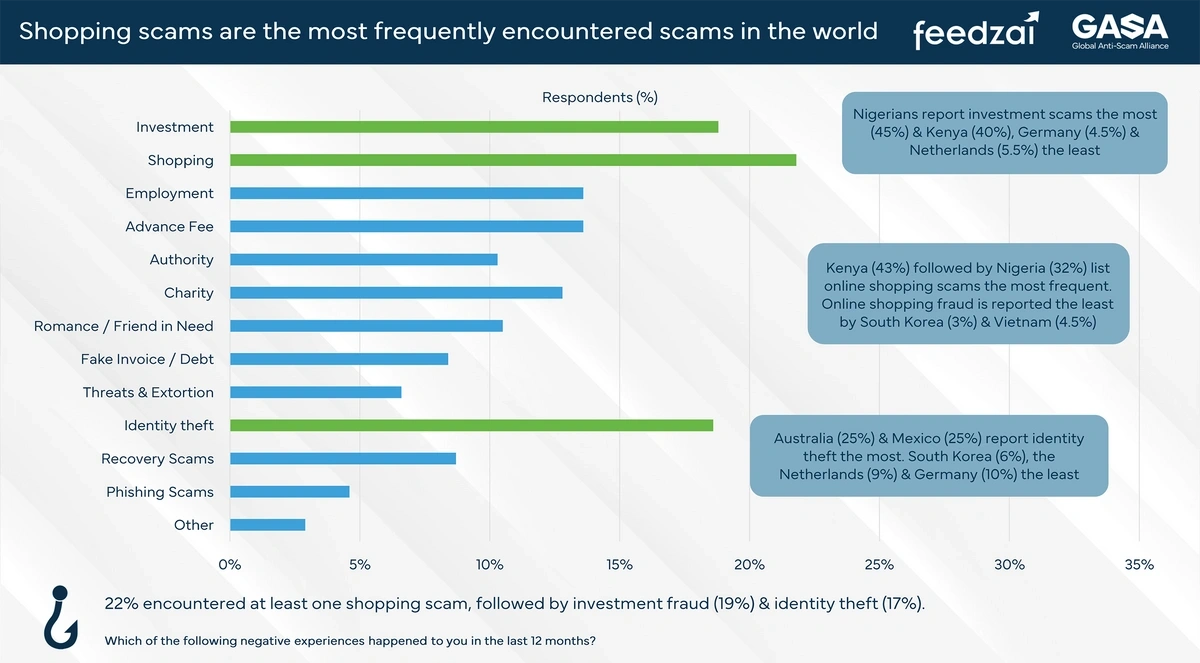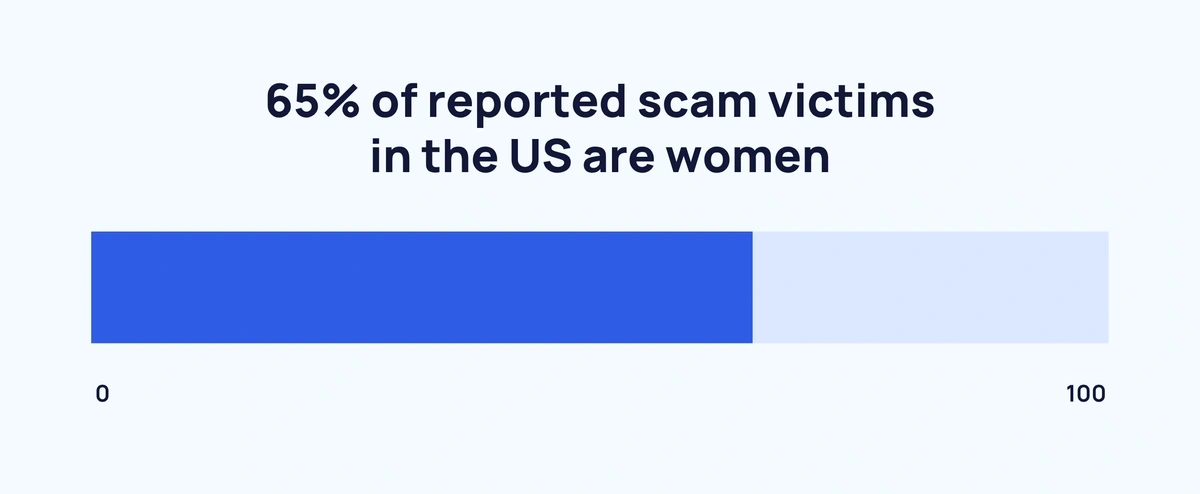
How many people have been scammed? (2025 statistics)
Every year, new scams emerge and more people fall victim to scammers. But exactly how many people have been caught out?
I’ve taken a look at some of the major statistics around scammers, including the number of scams in the US and worldwide, the amount of money taken, and some of the most common scam techniques.
Top Scam Statistics
- More than 1 in 3 US adults have experienced a scam or financial fraud in the last year
- Worldwide, an estimated 608 million people each year fall victim to a scam
- Scammers stole over $1 trillion globally last year
- US scam victims lost 25% more money this year than last year
- The most common type of scam in the US is identity theft
- 67% of US scam victim reports come from women, but men lose more money on average
How many people have been scammed in the US?
Almost 80 million people in the US have lost money to scams in the last 5 years.
In the past 12 months, 34% of US adults have experienced a scam or financial fraud (without necessarily losing money).
Over the course of a lifetime, 68% of US adults have experienced a scam. 30% have faced more than one type of scam.
Sources: FeatureSpace, BankRate
How many people have been scammed worldwide?
It’s hard to pinpoint an exact number of scam victims worldwide. But some studies can give an indication of the scale.
One survey covered the US, the UK, Canada, France, Germany, Italy, Japan, Australia, New Zealand, Singapore, Argentina, Brazil, Mexico, Portugal, and Spain. Over a three-year period, there were roughly 228 million victims in those countries, and more than 331 million total scams.
Those countries make up around one-eighth of the global population. Extrapolating, that would mean approximately 1.82 billion scam victims every three years, and 2.65 billion global scams.
That amounts to roughly 608 million victims of scams worldwide every year. Or to put it another way, there are 1.67 million scam victims per day.
However, this does not fully account for the variation in the number of scams by country.
In Brazil, 41% of the population encounter scams every day. A third of people in Hong Kong and over a quarter of people in South Korea say the same.
Sources: SMF, Global State of Scams Report
How many people get scammed online?
The internet is a powerful tool for scammers. However, online scams are still not quite as prevalent as mobile scams.
Worldwide, phone calls and SMS messages remain the most common methods of conducting scams. Over 60% of people have been approached by scammers via call or text in the past 12 months.
Email is the next-most popular medium. Almost 50% of people have experienced an email scam in the last year.
Instant messaging, social media, and digital advertising complete the top six, underlining the prevalence of online scams. Fewer than 10% of people in the last year have experienced a scam carried out through an in-person interaction.
In the US last year, 859,000 people filed complaints with the FBI about internet-related scams.
Sources: Global State of Scams Report, Waka
How much money is scammed each year in the US?
Consumers lost $12.5 billion to fraud in the US last year. That’s a 25% year-over-year increase.
The average amount lost to scams is $545. But 13% of scam victims lose in excess of $10,000, and 27% lose between $1,000 and $9,999.
Romance scams are the most costly, with victims losing an average of $2,000. This is lost over an average of 3.6 payments.
“Romance scams” searches are up by 75% in the last 5 years.
Investment scams are the next-most expensive, causing average losses of $1,104.
Nevada has the largest total cybercrime losses per person in the US, factoring in low-value scams and higher-value fraud. Its annual losses exceed $96 per resident.
Mississippi is the statistically least-scammed state, with losses below $23.60 per capita.
Sources: Federal Trade Commission (FTC) , FeatureSpace, Upwind
How much money is scammed each year worldwide?
Scammers stole $1.03 trillion last year. The vast majority of this money went unrecovered, with just 4% of victims recovering all their losses.
Developing countries like Pakistan, Kenya and South Africa each lost over 3% of its GDP to scams.
Bank transfers are the most common way for scammers to receive money, followed by E-wallets and credit cards.
Different studies have different methodologies, so figures cannot necessarily be compared directly. But here’s the scam data from a selection of major countries:
Australia keeps a running log of scams and losses. In the first 4 months of 2025, there were 72,230 reported scams, resulting in a loss of over $76 million USD.
$15.35 billion (£11.4 billion) is scammed each year in the UK. Fraud is the most prevalent crime in England and Wales.
In Canada last year, victims of fraud and cybercrime lost more than $461 million USD.
Source: Global State of Scams Report, Scamwatch, Cifas, National Crime Agency, Royal Canadian Mounted Police
Is the number of scams increasing?
The number and value of scams is on the rise.
Comparing the last four years of Global Scam Reports shows a steep rise in the amount of money lost to scams worldwide:
| Year | Money lost to scams |
| 2021 | $46.8 billion (converted from Euros at today’s rates) |
| 2022 | $55.3 billion |
| 2023 | $1.06 trillion |
| 2024 | $1.03 trillion |
In the US, scam losses increased 25% YoY in 2024.
In the UK, victims lost $5.39 billion (£4 billion) more to scams in 2024 than in 2023.
Sources: Global Anti-Scam Alliance, FTC, Cifas
What are the most common kinds of scam?
Shopping scams are the most common kinds of scam worldwide. They have been encountered by 22% of consumers.
Investment scams are also commonplace, affecting almost 1 in 5 people (19%).
Want to Spy on Your Competition?
Explore competitors’ website traffic stats, discover growth points, and expand your market share.
Texts, phone calls and emails are the most common scam delivery methods.
In the US, identity theft is the most common kind of scam, affecting 24% of all victims. That’s followed by gift card scams (19%), E-commerce scams (16%) and debt collection scams (15%).
Meanwhile, a UK study from November last year tracked some of the fastest-growing types of scam:
Fake parcel delivery texts
An SMS or email scam. The scammer claims to be a seller or a delivery firm, providing a link to reschedule delivery or pay some kind of fee.
Social media marketplace scams
The rise of social commerce has seen a parallel rise in social media marketplace scams. Rapidly-deleted accounts sell products that never arrive.
“TikTok Shop scam” searches are up by 354% in the last 2 years.
AI voice cloning scams
The rapid development of artificial intelligence has led to the growth of AI cybercrime as well as AI cybersecurity.
In particular, “vishing” has become far easier with the improvement in voice cloning technology.
Vishing is a scam technique where criminals use voice calls to steal personal information from victims.
“Vishing” searches are up by 94% in the last 5 years.
In the second half of 2024, vishing attacks rose by 442%.
Money request from friend or family scams
In this scenario, scammers pose as friends or family, asking for a bank transfer. Thinking they are helping someone they trust, the victim makes the payment.
Event ticket scams
Popular, over-subscribed events are fertile ground for scams. These schemes are particularly insidious in that they target people who are desperate to see the artist or sports team they love, and who may be less cautious as a result.
Searches for “ticket scams” increased by 950% in the last 5 years.
UK consumers lost over £1 million in scams related to Taylor Swift’s Eras Tour alone.
Meanwhile, tickets for the FIFA World Cup in the US next year have already appeared on resale sites, despite the fact that no official tickets have been released yet.
Sources: Global State of Scams Report, FeatureSpace, Natwest, Crowdstrike, Lloyds, Athlon Sports
Want to Beat Your Competition?
Find out who’s linking to them and build a better backlink strategy.
Scam victim age demographics
Some demographics prove consistently more susceptible to being scammed, even though anyone can end up as a victim.
Older consumers are particularly at risk from scammers. In the US, 73% of Baby Boomers (aged 61-79) and 71% of Gen X (45-60) have experienced a financial scam.
By comparison, 63% of Gen Z have experienced a scam. That rises very slightly to 64% among Millennials.
Likewise, older generations are more likely to have faced scams within the last year.
Interestingly, however, that pattern is completely inverted when it comes to actually losing money from a scam. 53% of Gen Z who faced a scam in the last 12 months lost money, compared to 45% of Millennials, 32% of Gen X, and 26% of Boomers.
On the other hand, older victims of scams tend to lose more money.
For victims aged 65 and over, the median loss is $300, twice the overall average. The median loss for those aged 18-34 is $112.50.
Sources: Bankrate, BBB Institute For Marketplace Trust
Scam victim gender demographics
Women report being scammed far more often than men. Females account for 65% of scam reports in the US.
When it comes to actually being the victim of a scam, the reporting gap is even wider. 67% of victim reports come from women.
However, among self-reported victims, the median loss for men is almost $100 higher than it is for women. Men lose $205 on average, compared to $112 for women.
Sources: BBB Institute For Marketplace Trust
Make your anti-scam content stand out
That wraps up our comprehensive list of scam statistics.
If you’re just checking out the state of scams in 2025, we hope you’ve found these statistics interesting and insightful.
Stop Guessing, Start Growing 🚀
Use real-time topic data to create content that resonates and brings results.
Exploding Topics is owned by Semrush. Our mission is to provide accurate data and expert insights on emerging trends. Unless otherwise noted, this page’s content was written by either an employee or a paid contractor of Semrush Inc.
Share
Newsletter Signup
By clicking “Subscribe” you agree to Semrush Privacy Policy and consent to Semrush using your contact data for newsletter purposes
Written By


James is a Journalist at Exploding Topics. After graduating from the University of Oxford with a degree in Law, he completed a... Read more











